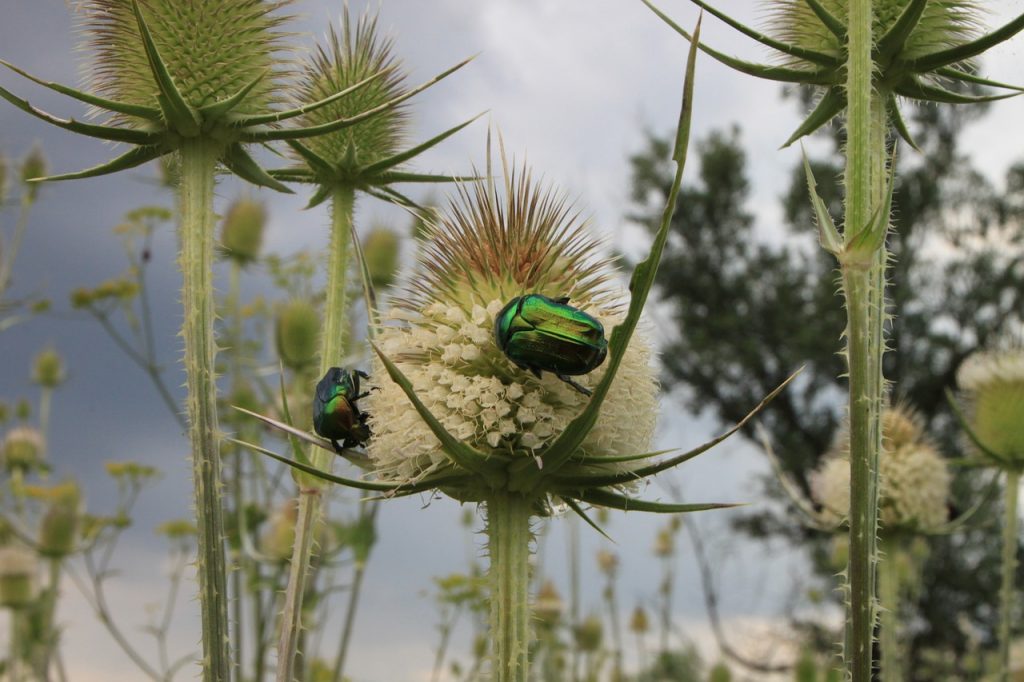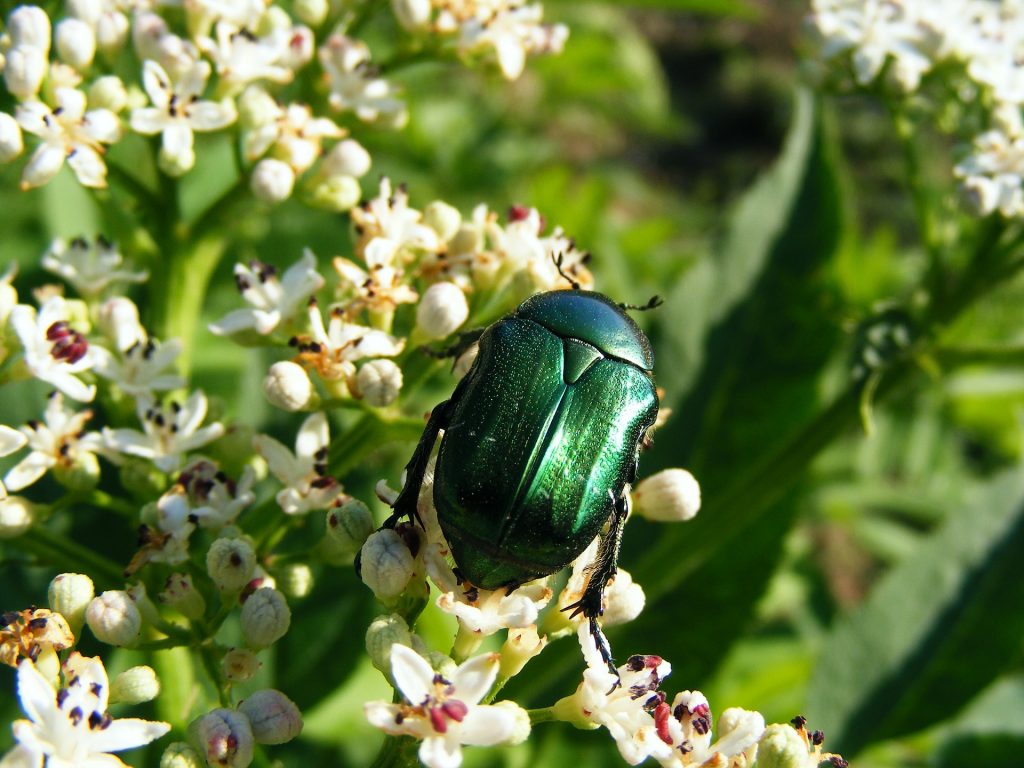Have you ever wondered what those shiny metallic green beetles you encounter ever so often are when enjoying the beautiful, lush outdoor scenery?
These shiny green beetles boast various bynames in different countries, but are more commonly known as Green June Beetles or simply called June Bugs. The ‘Green June Bug’ label is fitting, as adults make their buzzing appearance in the month of June.
Metallic green beetles may appear as innocent, harmless insects but are actually considered pests. This post is a brief profile of the description, life cycle, and other pertinent details about the shiny metallic green beetle.
- Scientific Name: Cotinis nitida (L.)
- Order: Coleoptera
- Family: Scarabaeidae (Scarab Beetles)
Note: If the green June beetle isn’t the bug you’re trying to identify, consider reading this article about ten beetles with shiny green colors.
Description of the Metallic Green Beetle
The shiny green beetle’s eggs are oblong or oval in shape and have opaque grayish shells. Unlike the eggs of other bugs, the female green June beetle burrows underground and deposits the eggs there, which takes about 14 days to hatch.
The emerging larvae – more commonly known as grubs – are worm-like with translucent white bodies. They have three pairs of legs and a dark brown head.

Their bodies often form a fetal C-shaped position. Metallic green beetles commonly remain underground, growing up to 2 inches in length. Emerging adults have a distinct shiny, metallic dark green to yellowish or brownish-green color wing covers or elytra, and a dull dark green head.
These small shiny green beetles only grow to about 1-inch in length and half an inch in width.
Life Cycle of the Shiny Green Beetle
Green June beetles have a relatively long life cycle and are only capable of producing new off-springs once a year.
Eggs of the metallic green beetle are usually lain on loamy to sandy soil around the end of the summer season and hatch after two weeks. The grub will continue living underground for almost a year; feeding on decaying organic plant matter, roots, shoots, and even poop up until winter months.
And then, these grubs will pupate around springtime. Come summer, usually around the middle of June, adult green June beetles will start emerging aboveground up until July.
Destructive Stage of the Green June Beetle
The most destructive stage of these metallic green beetles is during its larval stage. And, it’s all thanks to the seemingly insatiable appetite of their grubs and their powerful chewing mouthparts which can practically chew even tough plant parts.

Although not as destructive, their adult versions are also considered as pests since they gouge out fruit peels and often bury themselves within the flesh as they feed.
Host Plant of Metallic Shiny Beetles
These metallic green beetles love over-ripe or decaying soft fruits and even flowers as adults. But their grubs fancy a different kind of meal, mostly feeding on grains like oats and sorghum, as well as corn and some other vegetables, ornamentals, and even turf grass.
Control of Green June Beetles
There are a few management practices when dealing with these shiny green beetles. Ensure to check for the existence of green June beetle grubs by cutting small random sections which are about 4 inches by 4 inches big on turfgrass.
Use recommended pesticides in order to kill these green metallic beetle grubs, but take caution when applying it.
For fruit orchards, once you see a few green June beetle adults buzzing about, it’s already a sign that they may have fed on some of your ripe fruits. You can also check for physical damages on the fruit’s surface.
Other Types of Shiny Metallic Green Beetles
1. Jewel Beetles (Buprestidae):
The Buprestidae family, commonly known as jewel beetles or metallic wood-boring beetles, is renowned for its stunning assortment of colors. These beetles are often characterized by their elongated and streamlined bodies. They possess intricately patterned elytra (hardened forewings) that showcase an array of metallic hues such as emerald green, sapphire blue, ruby red, and golden yellow. One notable example is the aforementioned Chrysochroa fulgidissima, the shiny metallic green beetle, which is revered for its vivid green coloration resembling a shimmering emerald.
2. Rainbow Beetles (Euchirinae):
The Euchirinae subfamily is home to a group of beetles known as rainbow beetles. These fascinating insects possess a kaleidoscope of colors on their exoskeletons, creating an awe-inspiring display. Each individual beetle reflects and refracts light, producing a stunning spectrum of colors reminiscent of a vibrant rainbow. The rainbow beetles, with their metallic greens, blues, purples, and even hints of red and orange, are a true testament to the wonders of nature.
3. Rose Chafers (Cetoniinae):
Belonging to the Cetoniinae subfamily, rose chafers are known for their elegance and captivating colors. These beetles often feature a metallic green or golden exoskeleton, with some species displaying additional intricate markings or patterns. One well-known example is the Protaetia cuprea, commonly referred to as the rose chafer. This beetle boasts a metallic green body with striking copper-colored elytra, creating a striking contrast that enhances its visual appeal.
4. Green Ground Beetles (Carabidae):
Although not commonly associated with metallic colors, certain species within the Carabidae family surprise us with their shiny exoskeletons. The ground beetles, typically known for their black or dark brown hues, occasionally exhibit metallic shades of blue, green, or purple. These vibrant colors are often present on their elytra, catching the eye and adding a touch of brilliance to these nocturnal creatures.
5. Green Longhorn Beetles (Cerambycidae):
The Cerambycidae family, or longhorn beetles, includes an astonishing array of species, many of which display remarkable metallic colors. These beetles are characterized by their elongated bodies and long antennae. Their metallic exoskeletons can feature shades of gold, bronze, green, blue, or even a combination of several colors. The visually striking Prioninae subfamily, in particular, showcases longhorn beetles with impressive metallic patterns that are truly captivating.
These are just a few examples of the many types of shiny metallic green beetles found worldwide. Each species possesses its unique combination of colors, patterns, and physical attributes, enchanting entomologists, collectors, and nature enthusiasts alike. Their extraordinary beauty serves as a testament to the incredible diversity of life on our planet.







